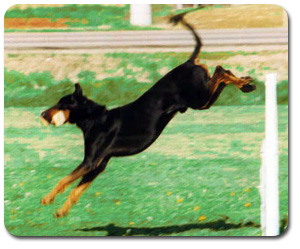
American Black and Tan Coonhound
Origin: United States
Height:
- – Males: From 25 to 27 inches (64 to 69 cm)
– Females: From 23 to 25 inches (58 to 64 cm)
Weight: 65 to 100 lbs. Should be in proportion to a dog with moderate bone and good muscle tone.
CLICK HERE to View Breeder Listings
Breed Profile
The Black and Tan Coonhound is a descendant of the Bloodhound and American Foxhound. His original job was to trail raccoons and help to rid farmers of them. The breed is one of the many tracking breeds developed in the southern United States. Known as the American Black & Tan Coonhound by the United Kennel Club, this was the first coonhound breed to be admitted into the registry in 1900 and was originally registered as the American Black & Tan Fox & Coonhound. Although, six distinct breeds of Coonhounds were developed in the U.S.: the Plott, English Coonhound, Redbone, Treeing Walker, Bluetick, and the Black and Tan; only the Black and Tan has been officially recognized by the American and Canadian Kennel Clubs. The United Kennel Club registers all six.
The Coonhound is even-tempered, outgoing, and friendly. He is a powerful, agile and alert dog who is not aggressive toward other dogs or people. He has the courage and stamina to hunt deer, bear and mountain lion. Being an active working dog who hunts by scent and works the trail with determination, he needs lots of outdoor activity.
Health Issues
The average lifespan of a Black and Tan Coonhound is about ten years. If you are considering the adoption of a Black and Tan Coonhound puppy, or any breed, it is very important to be selective in choosing a responsible and reputable breeder. Ensure that the prospective puppy’s parents have all health clearances. Breeding of any dog should not be done until after they have been proven to be free of evidence of significant hereditary diseases. (For more information on selecting a breeder, see the articles on the General Information page.)
Recommended Health Screening:
For the Black and Tan Coonhound, the the CHICNote 1 database includes health screenings for:
- Hip Dysplasia;
- Eye Examination by a board Ophthalmologist;
- Congenital Cardiac Database;
- Elbow Dysplasia and Autoimmune Thyroiditis are listed as optional.
Additional Health Resources:
- Health and Nutrition — This section of the Canada’s Guide to Dogs website includes information on several health and nutrition related issues.
- Canine Health Information Center (CHIC) — Providing a source of health information for owners, breeders, and scientists that will assist in breeding healthy dogs. CHIC is a centralized canine health database jointly sponsored by the AKC/Canine Health Foundation (AKC/CHF) and the Orthopedic Foundation for Animals (OFA).
- AKC Canine Health Foundation — Working towards developing scientific advances in canine health.
- Orthopedic Foundation for Animals (OFA)
- Ontario Veterinary College (OVC)
- University of Pennsylvania Hip Improvement Program (PennHip)
- HealthGene — HealthGene Corporation is the leading provider of veterinary DNA diagnostic services in Canada.
- Labgenvet — Laboratory of Veterinary Genetics is a Canadian diagnostic laboratory that offers a comprehensive service of DNA tests for veterinary genetic diseases.
Breed Standards
- CKC Breed Standard
- AKC Breed Standard
- UKC Breed Standard for the American Black and Tan Coonhound
- FCI Breed Standard No 300
- Illustrated Study of the Black and Tan Coonhound — from the American Black and Tan Coonhound Club
Grooming Information
The Coonhound’s coat tends to shed throughout the year and requires regular brushing.
- Grooming — This section of the Canada’s Guide to Dogs website includes tips, articles and information covering all aspects of dog grooming along with a listing of Groomers from across Canada.
Training Resources
- Training — For training information, see this section of the Canada’s Guide to Dogs website for tips, articles, as well as listings of training centres across Canada.
Additional Information
- Living with a Coonhound by Susan Pedley
- Clubs, Sports & Activities — For information on the many sports and activities you can get involved in with your dog.
- Working Dogs — The Working Dogs section of the Canada’s Guide to Dogs website provides information and listings of organizations that are involved in various dog jobs, such as Guide Dogs, Therapy Dogs, Police Dogs, Protection Dogs, and much more.
*NOTE 1: CHIC – The Canine Health Information Center “is a database of consolidated health screening results from multiple sources. Co-sponsored by the Orthopedic Foundation for Animals (OFA) and the American Kennel Club (AKC) Canine Health Foundation, CHIC works with parent clubs to identify health screening protocols appropriate for individual breeds. Dogs tested in accordance with the parent club established requirements, that have their results registered and made available in the public domain are issued CHIC numbers.” To learn more, visit: www.caninehealthinfo.org
*NOTE 2: The Fédération Cynologique International (FCI) is the World Canine Organization, which includes 91 members and contract partners (one member per country) that each issue their own pedigrees and train their own judges. The FCI recognizes 344 breeds, with each being the “property” of a specific country. The “owner” countries write the standards of these breeds in co-operation with the Standards and Scientific Commissions of the FCI, and the translation and updating are carried out by the FCI. The FCI is not a breed registry nor does it issue pedigrees.
Breed Listing
Quick Links
Get In Touch
- Email: canadasguidetodogs@gmail.com
- Email: info@canadasguidetodogs.com
- Visit us on Facebook: www.facebook.com/CanadasGuideToDogs
— CanadasGuideToDogs.com is an Amazon Associate as well as a participant in various affiliate programs, as such fees are earned from qualifying purchases.

